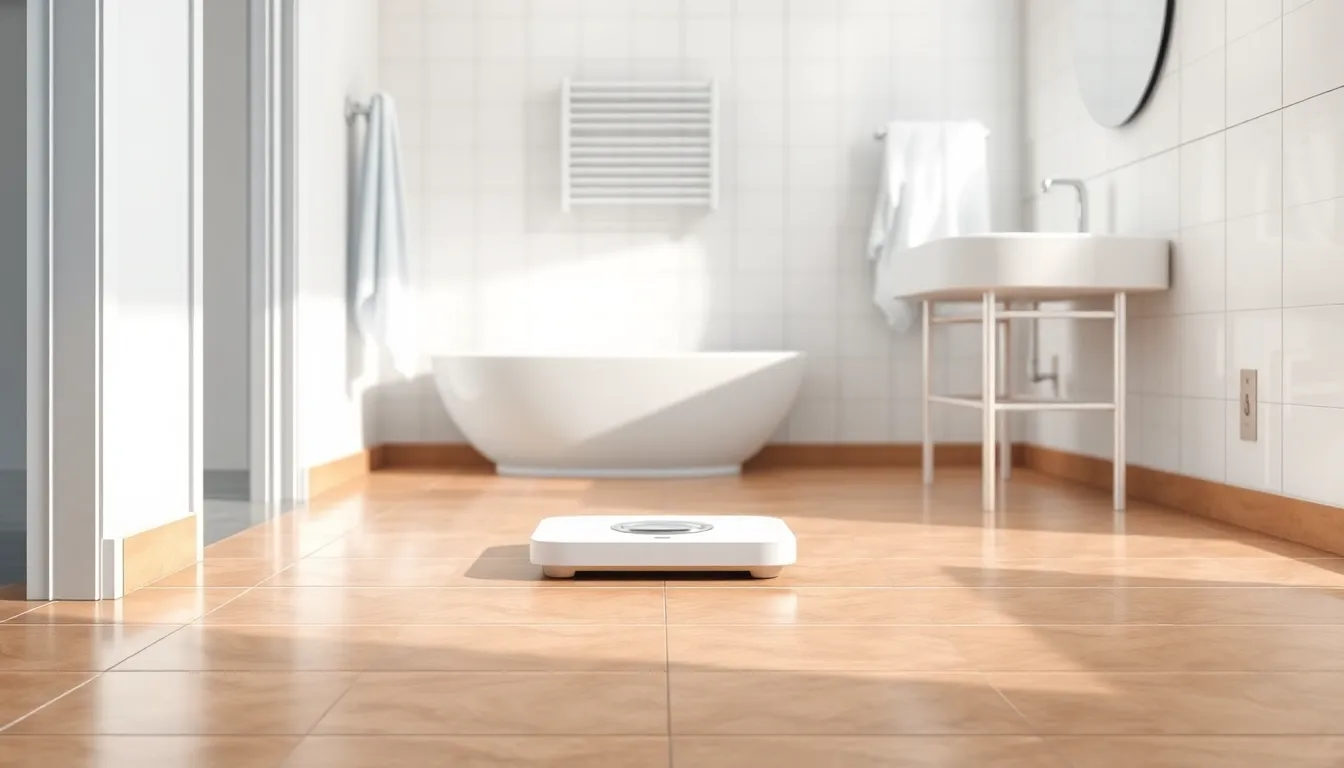Finding the perfect spot for a bathroom scale might seem trivial, but it can make or break your weight-loss journey. Imagine stepping on that scale only to realize it’s on a wobbly tile or hidden behind a laundry basket. Talk about a rude awakening! The right placement not only ensures accurate readings but can also turn your daily weigh-in into a moment of triumph rather than a game of hide-and-seek.
Think of your scale as the referee in your fitness game. You wouldn’t want it perched on a slippery surface or in a dark corner, right? Proper placement can boost your motivation and help you keep track of your progress. So let’s dive into the quirky world of bathroom scale placement and discover how a simple adjustment can lead to a healthier, happier you.
Table of Contents
ToggleImportance of Bathroom Scale Placement
Bathroom scale placement plays a critical role in achieving accurate weight readings and fostering a positive mindset regarding weight management.
Impact on Accuracy
Accurate weight readings depend heavily on the scale’s location. A scale positioned on uneven surfaces may yield inconsistent results, leading to frustration. Placing the scale on a hard, flat surface ensures reliable measurements. Areas such as tile or hardwood floors provide the best conditions for precise readings. Users should avoid carpets, as they can distort weight measurements. Consistency in placement also contributes to accuracy; consistently weighing oneself in the same spot yields trustworthy data over time.
Influence on User Behavior
Location influences how individuals approach their weigh-ins. A visible, easily accessible scale can encourage routine use, boosting motivation during weight loss efforts. If individuals place their scales in hidden or inconvenient areas, they may neglect their weigh-ins, impairing commitment to their goals. Regularly stepping on the scale reinforces accountability and fosters a habit of monitoring progress. Even subtle adjustments in placement can lead to improved weight management practices, supporting overall health objectives.
Ideal Locations for Bathroom Scale

Proper placement of a bathroom scale plays a crucial role in achieving accurate weight measurements. The following guidelines ensure optimal placement for effective use.
Level Surfaces
Choosing a level surface for the scale ensures consistency in weight readings. Hard surfaces, like tile or hardwood, provide stability. Avoid placing the scale on uneven or soft surfaces, such as carpets. Carpets can absorb pressure, leading to inaccurate results. Utilize flat areas in the bathroom, such as near the sink or on a ceramic tile floor. A reliable measurement demands a consistent standing position, which is only achievable on a firm surface.
Away from Moisture
Moisture can affect the functionality of a bathroom scale. Position the scale away from areas prone to splashes, such as near the shower or bathtub. Humidity can cause internal components to malfunction over time. Keeping the scale dry enhances its longevity and accuracy. A well-ventilated location reduces moisture buildup. For best results, place the scale near a wall or in a corner where water exposure is minimal. Prioritizing a dry setting translates into dependable measurements that support weight management efforts.
Common Mistakes in Bathroom Scale Placement
Understanding common mistakes in bathroom scale placement helps individuals achieve accurate weight readings. Even small errors can affect motivation and overall progress.
Placing on Carpets
Placing a scale on carpets often leads to inaccurate readings. Carpets can absorb pressure unevenly and prevent the scale from providing a consistent measure of weight. Instead of achieving reliable results, individuals may find their data fluctuates, causing confusion and discouragement. Utilizing a scale on a hard surface, such as tile or hardwood, ensures stability and improved accuracy. The difference in results when on a flat surface versus a carpet can be significant. Users must prioritize this detail to maintain motivation during their weight management journey.
Near Heating Sources
Locating a scale near heating sources can introduce unwanted variables into the measurement process. Heat can cause scale components to expand, leading to inaccuracies. Additionally, moisture from humidity can also distort readings, as humidity affects the scale’s internal electronics. By placing the scale away from heaters and vents, users promote an environment that encourages reliable weight assessments. Ensuring a consistent environment supports the accuracy of readings and helps individuals stay on track with their fitness goals. Prioritizing an appropriate location is essential for effective weight management practices.
Tips for Optimal Scale Usage
Proper usage of a bathroom scale can enhance accuracy and support weight management goals. Considering adjustments can lead to more consistent readings.
Regular Calibration
Regular calibration of the scale ensures accurate measurements over time. Performing calibration every month helps counteract any gradual shifts in weight readings. Users familiar with the scale’s manual understand the calibration process often involves resetting to zero. They should take the time to follow instructions precisely to maintain accuracy. In addition, keeping the scale on a flat surface aids in obtaining precise results. Weighing the same object repeatedly can also verify consistent functionality. Users will appreciate reliable measurements for their weight management journey.
Consistent Timing
Weigh-ins at consistent times boost the accuracy of weight records. Choosing a specific time each day, such as in the morning, allows for standardized comparisons. After waking, the body remains in a similar state, free from food or drink alterations. Users likely recognize how daily fluctuations occur based on hydration and meal intake. Recording weight under similar conditions reduces the chances of misinterpretation. They can maintain a log through applications or notebooks to track their progress effectively. Uniformity in timing ultimately leads to better assessment of weight loss goals.
Proper bathroom scale placement is essential for achieving accurate weight readings and maintaining motivation. By selecting a hard, flat surface away from moisture and heat sources, individuals can ensure their scale provides reliable data. Accessibility also plays a key role; an easily reachable scale encourages regular use and supports consistent weigh-ins.
Incorporating these simple strategies can transform the weighing experience into a positive part of a weight management journey. With mindful placement and usage, the scale can become a valuable ally in achieving health and fitness goals.



